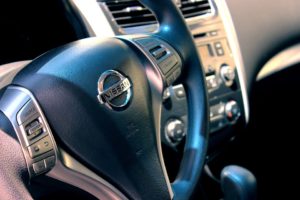Types of Power Steering
If you have been wondering how power steering works, you’re not alone. Using an alternative power source to supplement a driver’s input, power steering boosts the force and directs it to the wheels of a vehicle.
While unassisted steering can still be used as a way to drive a vehicle, the increasing weight and width of vehicles has made turning more difficult. To overcome this issue, manufacturers have incorporated power steering systems to reduce the amount of effort required to turn the front wheels. These systems communicate a fraction of the tire’s forces to the hands of the driver, resulting in lighter steering effort.
Power steering predates the automobile. The underlying technology has evolved, resulting in several variations. Let’s take a look at some of the types.
Hydraulic Power Steering (HPS)
If your vehicle was built between the 1950’s and early 2000’s, it most likely has hydraulic assisted steering. This type uses a pump, powered by the engine, to send pressurized fluid throughout the steering system. HPS has worked well and been successfully mass produced for over 50 years. However, there are some drawbacks.
The hydraulic pump is driven by the engine and is running constantly, making HPS an inefficient system. When you are driving your car straight on the highway, power steering isn’t needed, but the pump will still be spinning. Since the pump is providing pressure even when you’re not turning, energy is wasted.
All those hydraulics need to be properly maintained. The power steering fluid needs to be replaced from time to time. Also, if any of the hydraulic lines have a leak this could cause a complete loss of steering assistance, so they should be checked periodically when performing preventative maintenance.
How does a hydraulic power steering system work?
The steering wheel is connected to the top of a thin metal rod called the torsion bar or steering column. As the driver turns, torque is applied. The rod will twist, turning the pinion gear, located at the base of the column.
The rotary valve’s main job is to assess how much torque the driver provides. When the valve is centered, pressure on left and right is equal and the vehicle’s wheels will be straight. When turning one valve opens further, high pressure fluid will flow to the corresponding side of the system. This causes the wheels to turn in the direction the driver chooses.
A gear-set housed in a metal enclosure, typically rack and pinion, transforms the circular motion of turning the steering wheel into the linear motion needed to turn the wheels. Some vehicles make use of a pitman arm set up for this action, like parallelogram steering.
This linear motion is communicated through the tie rods to the knuckles. The knuckles are what the front wheels attach to and pivot on when the wheel is turned.
In a hydraulic steering system an engine-powered rotary vane pump continuously pressurizes the fluid. The vanes of the pump spin inside an oblong chamber. Spinning pulls hydraulic fluid from the return line, forcing it through the outlet, providing the rack with high pressure fluid. The amount of fluid flow depends on the engine’s speed.
For safety, a pressure relief valve helps make sure the pressure does not get too high.
Electro-Hydraulic Power Steering (EHPS)
A defining characteristic of electro-hydraulic power steering is the electric motor turning the hydraulic pump. This allows pressure to be controlled independent of the engine’s condition. Having a motor take electricity from the battery, not the engine, frees up horsepower for performance. This system is still susceptible to any issues that come with the reliance on hydraulics.
Electric Power Steering (EPS)
Electric power steering uses an electric motor located at the base of the steering column or rack. It works by detecting the angle of the steering wheel and translating the driver’s input into movement of the front wheels. The electric motor provides variable assistance without using hydraulics, hoses, belts or a fluid pump. EPS has proven to be a reliable system and is equipped today on most new vehicles. You can expect an immediate response time when turning the wheel. Less parts means less maintenance, and computers perform most adjustments for small alignment problems or unusual road conditions.
Steer by Wire
Some vehicles go one step further, possibly too far, and use a steer by wire system. This type of system has no mechanical connection between the steering wheel and tires (no steering column). Control comes from numerous electric motors,sensors and actuators. Drivers make a turning request with a steering wheel, yoke or possibly even a smart-phone. Without mechanical linkages as a fallback, a loss of power will also mean a lack of steering. However, this is the most cost effective method since it’s a bare minimum computer controlled system. Steer by wire may also be very important in a future with driver-less cars. Cars that may not even have steering wheels or dashboards, enabling the most space possible for passengers and cargo.
To Sum It Up
A great steering system connects the driver with the road and the car. Hydraulic Power Steering requires more horsepower and maintenance than EPS, and contributes to less gas mileage. Electro-Hydraulic Power Steering provides better fuel economy than HPS. Electric Power Steering, by eliminating hydraulics entirely, reduces maintenance to a minimum. Steer by Wire may be the best system when the driver is exclusively a computer.
References
https://auto.howstuffworks.com/
https://www.nissan-global.com/
https://americanpowertrain.com/

